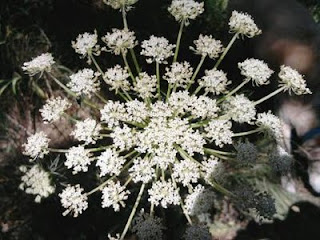Almost every day I walk with my dogs in a small woods that runs alongside a canyon creek near our inn. Over the past three years, I've become very fond of these woods, the little creek, and the tiny waterfall that marks our turnaround point.
 |
| Franny and Zoey at Oredson-Todd Woods in Ashland, OR |
Since writing the Simple Explanation, I've been noticing toroids in the trees. Look--
 |
| Tree Torus |
My cell-phone photos do not do justice to this sensuous, rounded tree torus. Each tree has a torus wherever a branch existed and exists no more. When the branch goes away, the tree's skin fills in and rounds out the hollow.
For that matter, the torus is there from the beginning of the branch, as well. You could say that the branch emerges out of the torus form, like a stick poking out through a donut. It is difficult to observe this at the formative stage, but you can see how it happened in retrospect, by examining a branch in the process of going away.
In the photo above, you see a dead branch on its way out, emerging out of the torus in the wall of a fallen tree. Had this been a live tree, the skin would have grown back around the hole left behind after the branch stump finally fell out, forming the torus shape in the earlier photo.
 |
| Tree in process of reforming a torus shape around a sawn-off limb. |
In the same manner that the Simple Explanation suggests each of our organs has "a mind of its own" with its own governing UC attached to it, so each tree branch is a separate and distinct entity, a fractal of the mother tree. Each branch as a job to do, to follow the sun and gain nourishment from the rain and sky, in order to contribute to the tree's greater good. When it is no longer able to do its job, the branch withdraws into its original torus shape from which it emerged.














